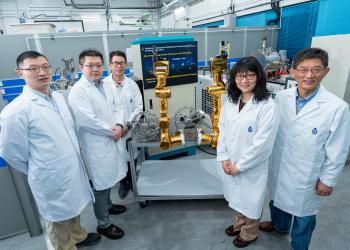HKUST-led Research Successfully Develops Rechargeable Liquid Fuels to Power Electric Vehicles and Electricity Grid
A cross-university research project led by The Hong Kong University of Science and Technology (HKUST) has successfully developed an environment-friendly rechargeable liquid fuel that promises to have impact on a global scale. It can fully recharge an electric vehicle in a matter of minutes – a great enhancement from existing battery technology which usually takes hours.
This fuel – called ‘e-fuel’ – is carbon-neutral if charged with solar or wind energy. Like fossil fuels, it can be readily dispatched to the power grid, and also rapidly recharged to vehicles.
The research, titled ‘Creation of Rechargeable Electron-fuels for Stationary Power Supplies and Electric Vehicles’, is led by Prof. ZHAO Tianshou of HKUST and supported by academics from The University of Hong Kong, The Chinese University of Hong Kong, and The Hong Kong Polytechnic University.
Prof. Zhao Tianshou is Cheong Ying Chan Professor of Engineering and Environment, Chair Professor of Department of Mechanical and Aerospace Engineering, and Director of the HKUST Energy Institute. The five-year research project – from 2018 to 2022 – is funded by the Research Grants Council Theme-based Research Scheme to the tune of HK$50 million.
“We have successfully developed a stable lithium-sulfur battery that promises to be energy-dense and capable of storing energy at low cost, and can be applied to both electric vehicles and grids transmitting a high fraction of solar and wind energy,” Prof. Zhao explained.
“The biggest excitement for us is that we can transform the lithium-sulfur battery to a flow system, or e-fuel as we call it.”
Unlike recharging a battery for hours for an electric vehicle, recharging the vehicle with e-fuel takes a matter of minutes. And since it’s rechargeable, e-fuel won’t go away like fossil fuels do after the consumption. At the recharging station, the energy-depleted e-fuel is removed from the fuel tank, which then is refilled with fully-charged e-fuel.
The e-fuel system adopts the chemistry of a lithium-sulfur battery for the high capacity of the lithium metal and the low cost of the sulfur cathode. While the research team made great progress in developing e-fuel, they still had challenges to overcome. First, dendrites forming on the lithium surface may shorten the battery life. Second, the discharged sulfur will dissolve and diffuse to damage the lithium anode.
“A solution is to form a porous lithium anode with surface protection, previously achieved through impractical, strenuous fabrication procedures,” Prof. CHEN Qing, Assistant Professor in the same department who works on this project with Prof. Zhao, explained. “We make thermodynamics work for us. With two spontaneous reactions, we formed a porous lithium anode on a carbon skeleton, and coated it with a protective, composite layer.”
This simple yet effective approach led to one of the best performance records ever achieved for a high-loading lithium-sulfur battery. The loading – meaning the amount of active materials per area of the device, has to be high so that the high performance on paper can eventually translate into a practical, high-performance system.
While the research is still ongoing, selected results have already been published in Nature Communications – one of the world’s most prestigious multidisciplinary journals. Since the inauguration of the journal in 2010, HKUST has contributed 22 papers, most of which represent major breakthroughs in their respective fields.
For media enquiries, please contact:
HKUST School of Engineering
Diana Liu
Tel : 2358 8982
Email : egdiana@ust.hk
Dorothy Yip
Tel : 2358 5917
Email : egkkyip@ust.hk












